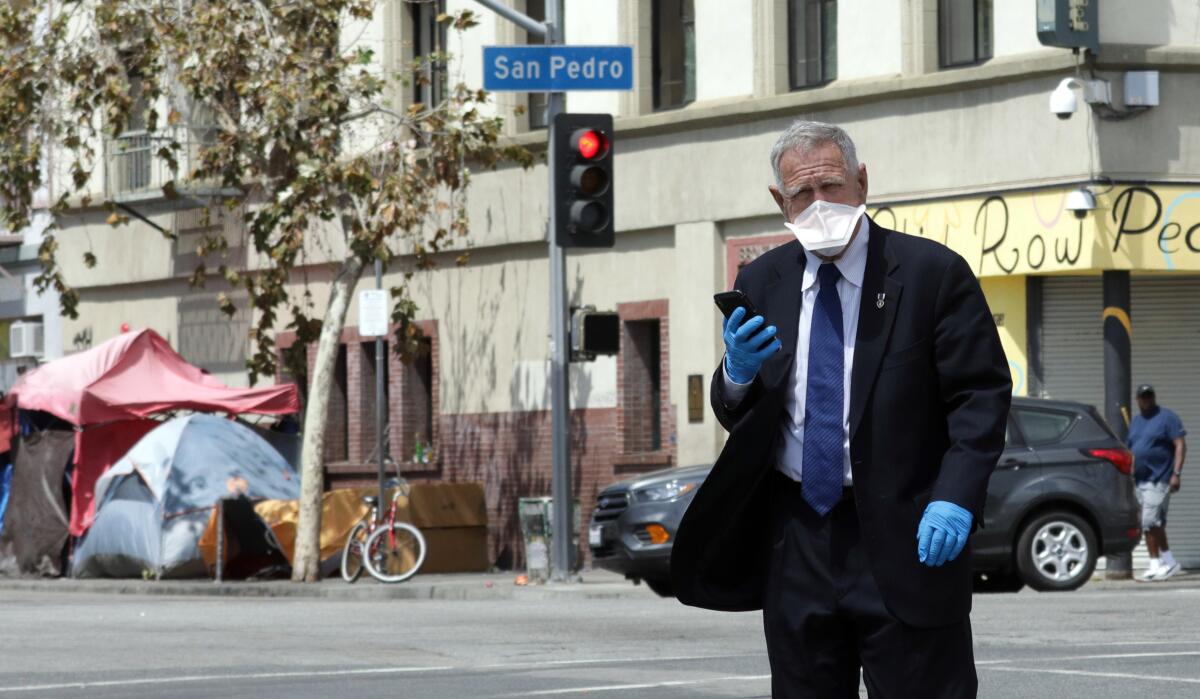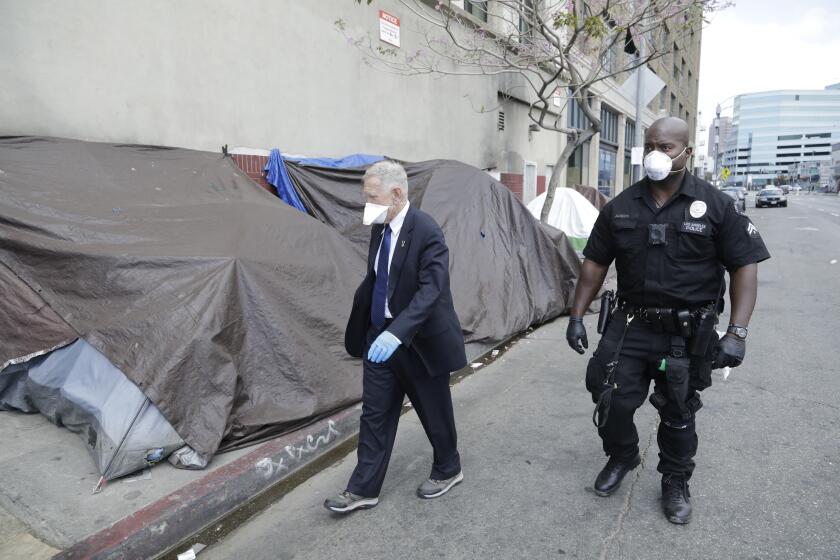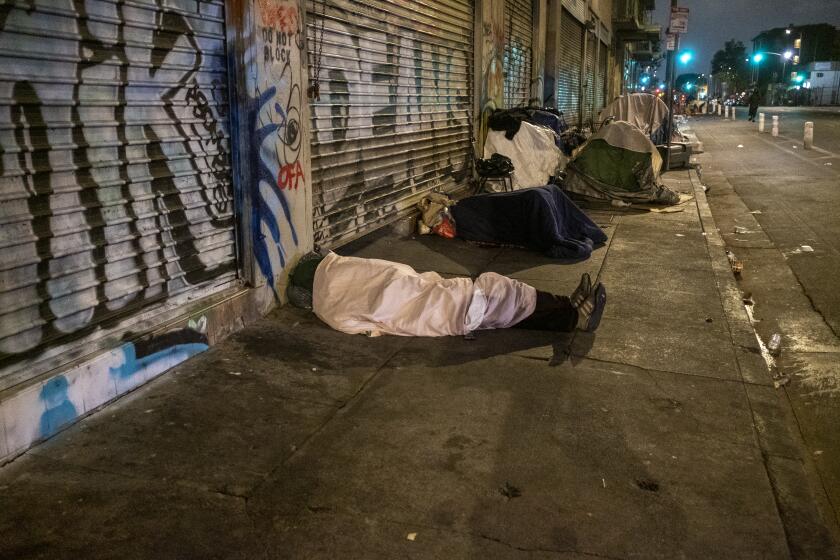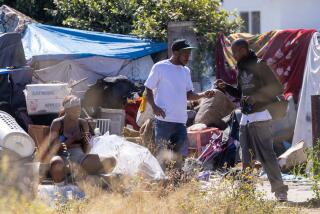Judicial overreach? Some say judge went too far in ordering L.A. to clear skid row

- Share via
The city and county of Los Angeles may have a strong case as they seek to overturn a sweeping federal judicial order requiring them to offer shelter to everyone on skid row, legal analysts who have followed the case say.
The city and county have asked for the order to be stayed until the appeal is heard by the 9th U.S. Circuit Court of Appeals. A stay would freeze the order from U.S. District Judge David O. Carter, including the requirement that the city put $1 billion in escrow to pay for the clearance, until the appeal was decided.
At the heart of Carter’s injunction is the argument that a long history of state-sponsored racism in Los Angeles has driven Black people into homelessness. Legally, the argument rests on the question of whether there’s a “state-created danger” and whether government inaction has put more people at risk.
The injunction was necessary, Carter wrote, because the city and county failed to fix the problem “despite numerous opportunities and resources to do so.”
Legal scholars say there’s precedent for judges to actively resolve what are thought to be gross constitutional violations.
A federal judge has ordered the city and county of Los Angeles to offer some form of shelter to skid row’s entire homeless population by October.
They say there are several questions that an appellate court panel will likely ask, including whether government has committed a constitutional violation by failing to help homeless people get off the streets. Additionally, it will look to see if the fixes Carter is proposing are appropriate for a court to craft and whether they go beyond the bounds and expectations of what a judge should be doing.
UC Berkeley law school Dean Erwin Chemerinsky, who knows Carter and read his order, said the judge does a good job in explaining why he sees a “state-created danger,” the idea that if government had acted more forcefully it could have prevented the calamity — tens of thousands of homeless people on the streets — from occurring. Still, he hastened to point out that the Supreme Court and other lower courts have been skeptical and often unwilling to accept arguments that state-created dangers existed even in the most egregious circumstances.
“The Supreme Court and the courts of appeals have been very restrictive with regard to finding state-created danger,” Chemerinsky said — adding that he was unsure how the case could play out at a higher court.
Moreover, a range of lawyers across the ideological spectrum don’t believe a higher court will buy that Carter should dictate policies that are normally decided by elected officials. His order has created a situation in which lawyers for the intervenors in the case — the skid row-based anti-poverty group Los Angeles Community Action Network — find themselves partially in agreement with entities they routinely and harshly criticize: the city and county of Los Angeles.
Carter bases his argument on a history of “containment,” in which poor people, especially people of color, were funneled into skid row and redlined out of more affluent — and whiter —parts of the city. This builds on a similar argument the plaintiffs in the case, the L.A. Alliance for Human Rights, made when they sought the order.
“This is a consequence of choices — choices made by the city and county, which have admitted repeatedly that they have caused this crisis and are unable to fix it,” Matthew Umhofer, an attorney for the L.A. Alliance, wrote previously. The alliance represents downtown businesses and residents.
But intervenors have pointed out that the containment strategy did not envision people living on the streets of skid row, which once had numerous flophouses and other cheap forms of housing. They added that starting in the mid-2000s, through various anti-crime strategies, the city and the Los Angeles Police Department actively tried to push people out of skid row — not keep them in.
A federal judge’s order calling on L.A. to provide shelter to all unhoused people on skid row by October is sparking growing alarm
The plaintiffs want Carter to “radically re-shift” the city’s strategy from one based on the needs of homeless people citywide and instead focus resources on areas where the homeless population frustrates business owners and residents, the intervenor’s lawyer, Shayla Myers, wrote in a legal filing before Carter issued his order.
“Then [the city will] deploy its police force to enforce an anti-camping ordinance against some of the most vulnerable members of the community,” she said.
The city and county have made similar arguments that it is the domain of elected officials and not a judge to set priorities on an issue that affects so many people.
“Deciding how to spend taxpayers’ money and deliver services to people experiencing homelessness is a legislative, not a judicial, function,” Skip Miller, whose Miller Barondess law firm is representing the county, said Wednesday. “The county remains committed to its course of urgent action outside of court addressing this complex societal issue with the city and its other partners.”
Edward Whelan, a former clerk for the late Supreme Court Justice Antonin Scalia and a senior fellow at the conservative-leaning Ethics and Public Policy Center in Washington, said he thought a higher court would likely grant a stay pending appeal because what Carter is demanding be done on very tight deadlines would deprive the city and county of many of the benefits of winning their appeal. In addition, Whelan didn’t find Carter’s detailing of the history of racism in housing persuasive enough to merit the actions the judge is saying the city must take.
“One of the problems I have with an expansive ruling and opinion like this is it could be applied to almost anything else,” Whelan said. “We have a society dealing with an entrenched legacy of racism that goes far beyond actions of the city and county, and the reasoning and grounds of the order here are very expansive and far beyond what the courts would ordinarily accept.”
The prospect of the case reaching an appellate court worries lawyers and advocates for homeless people — who have prevailed in several lawsuits that have enshrined protections for people on the street in places where there are not enough housing or shelter. They find the order problematic for several reasons, including that it prioritizes the construction of interim shelter and quick-fix solutions rather than pushing for permanent solutions such as more housing.
One such attorney anxious about the lasting consequences of the case is Eric Tars, who represented seven homeless people in the landmark Boise vs. Martin decision, in which the 9th Circuit ruled that criminally punishing homeless people for sleeping outdoors when there are not enough shelter beds or housing violated the 8th Amendment of the U.S. Constitution, which forbids cruel and unusual punishment
He worries that whatever happens at the 9th Circuit could deal a blow to a larger goal for advocates for the unhoused, which is to more firmly establish a right to housing. Many have been heartened by actions by the Biden administration to more fulsomely fund initiatives to make housing available to low-income Americans.
In court though, Tars is anxious that the 9th Circuit could undermine his larger efforts. He applauded Carter for recognizing that a region’s history of racism can drive people into homelessness. But he said the solution is not ordering more temporary congregate shelter.
“It’s not the legal theories we disagree with, because we want to see that kind of reasoning being upheld in other situations, but it’s just when you get to that last section where Carter describes what he thinks should be done about it, that the order goes off the rails,” he said.
Tars doesn’t want the 9th Circuit to embrace a view that temporary congregate shelter, not housing, is a solution for homeless people. Similarly, he doesn’t want the court to necessarily shoot down the idea that a judge in certain situations could step in and order a municipality to house people if it had failed to look after their safety. There are times when a judge should tell a city or county how to spend their money to help people, he said.
He does not believe, however, that this is the way to spend it.
More to Read
Sign up for Essential California
The most important California stories and recommendations in your inbox every morning.
You may occasionally receive promotional content from the Los Angeles Times.









